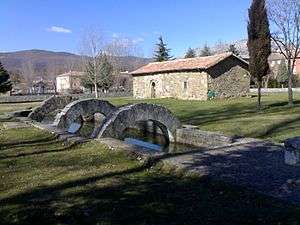Fontes Tamarici
| Spanish: Fuentes Tamáricas | |
 | |
| Year | 1st century BC |
|---|---|
| Type | Public fountain, oracle |
| Medium | Stone |
| Dimensions | 4.5 m × 2 m (15 ft × 6.6 ft) |
| Location | Velilla del Río Carrión, Palencia, Spain |
| 42°49′24″N 4°50′45″W / 42.82333°N 4.84583°WCoordinates: 42°49′24″N 4°50′45″W / 42.82333°N 4.84583°W | |
The Fontes Tamarici, in Spanish Fuentes Tamáricas (English: Tamaric Fountains) are three nearby springs located by the geographer and Roman historian Pliny the Elder in classical Cantabria, and since the 18th century are being identified with the source of La Reana in Velilla del Río Carrión (Palencia), Spain. The first news of the spring, by Pliny, dating from the time of the Roman conquest of Cantabria, it has the peculiarity that water emanating from the earth, and its intermittence was considered omen at this time.[1]
History
It is known that the tamarics cantabri was who inhabited the area from the 3rd century BC. They worshiped waters and the sacred springs. It is not known the exact year of its construction, but it is clear that when the Roman Empire conquered Cantabria (year 19 BC), they found these sources that drew wide attention. The outbreak irregular emptying its waters and unexpected, accompanied by the noise that precedes underground filling, had to be at that time matter of respect and adoration. Possibly they were used as baths, laundry and omen.[2] It has been also suggested that the fountain could be dedicated to a god of the waters, where predictions were made based on their irregular filling and emptying cycle. In the thirteenth century it was built beside a hermitage devoted to John the Baptist, to Christianize the place and delete all relations with pagan rites.[3]
The curse of Pliny

Studies of the naturalist and geographer Pliny the Elder on the lands occupied by the Roman Empire are crucial for knowledge and location of Tamaric Fountains. In his Naturalis Historiae, XXXI, 3, is where he alludes its particularity:
Tamaric Fountains, in Cantabria serves as omen. They are three, to eight feet of distance. They come together in one bed, each carrying a large flow. Usually dry for twelve days and sometimes up to twenty, leaving no sign of water, while another adjoining source still flowing without interruption and in abundance. It's bad luck try to see them when they run, as happened recently has the legacy Lartius Licinius, who, after his praetorship, he went to see them when they run dry, and he died seven days later.— Pliny the Elder, Naturalis historia, XXXI, 23
Lartius Licinius was a great supporter of the work of Pliny, with his intense desire for knowledge of new discoveries, he visited the spring when it were in their dry phase, and died a week after in 70 AD.[4]
References
- ↑ Santa María la Real Todo el románico de Palencia (2015). ISBN 8415072406, p. 132.
- ↑ Torres Martínez, Juan. El Cantábrico en la Edad del Hierro: medioambiente, economía, territorio y sociedad. Real Academia de la Historia (2011). ISBN 8415069286, p. 463
- ↑ Palencia Turismo Velilla del Río Carrión. Retrieved 23-04-2016
- ↑ Pliny XXXI 24: «sicut proxime Lartio Licinio legato post praeturam; post septem enim dies occidit».
External links
| Wikimedia Commons has media related to Fountain La Reana, Velilla del Río Carrión. |